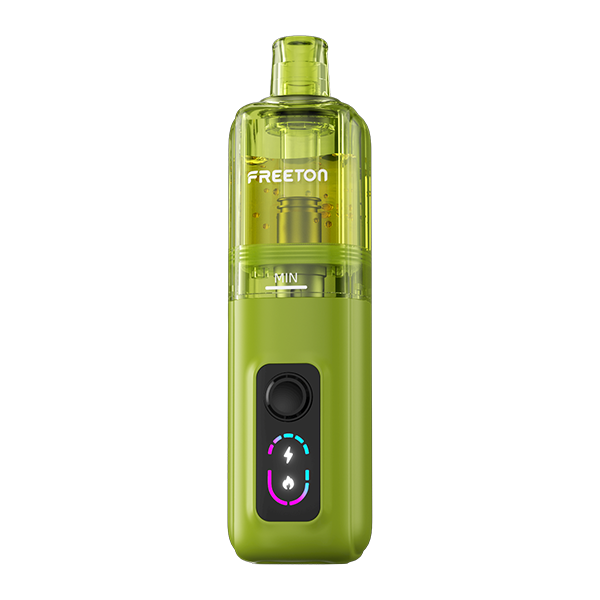
Disposable electronic cigarettes have gained significant popularity in recent years as a convenient and satisfying alternative to traditional cigarettes. Alongside this trend, there is a growing awareness of the importance of environmental sustainability. This has led to a demand for eco-friendly vaping solutions that minimize waste and reduce the carbon footprint. In this context, exploring […]
Disposable electronic cigarettes have gained significant popularity in recent years as a convenient and satisfying alternative to traditional cigarettes. Alongside this trend, there is a growing awareness of the importance of environmental sustainability. This has led to a demand for eco-friendly vaping solutions that minimize waste and reduce the carbon footprint. In this context, exploring how disposable electronic cigarettes offer green alternatives becomes essential to meet the needs of environmentally conscious vapers.
Environmental Impact of Traditional Cigarettes
Traditional cigarettes have a significant and detrimental environmental impact. The production, consumption, and disposal of traditional cigarettes contribute to various forms of pollution and resource depletion. Understanding the environmental consequences of traditional cigarettes is crucial in highlighting the need for eco-friendly alternatives like disposable electronic cigarettes.
One of the major environmental issues associated with traditional cigarettes is the generation of cigarette butt waste. Cigarette butts are the most commonly littered item worldwide, and they contain toxic chemicals that can leach into the soil and water bodies, posing risks to ecosystems and wildlife. Additionally, the manufacturing process of traditional cigarettes involves the use of non-renewable resources such as paper, filters, and packaging materials, leading to deforestation and excessive waste generation.
Furthermore, the combustion of tobacco in traditional cigarettes releases harmful emissions into the air, contributing to air pollution. Secondhand smoke, which contains numerous toxic chemicals and carcinogens, poses a health risk to both smokers and non-smokers. The impact of secondhand smoke on indoor air quality is particularly concerning, as it can linger and affect the health of individuals in enclosed spaces.
Tobacco farming, another integral part of the traditional cigarette industry, has significant environmental consequences. Large-scale tobacco cultivation requires vast amounts of land and water resources. This can result in deforestation, habitat loss, soil erosion, and the use of harmful pesticides and fertilizers. The environmental degradation caused by tobacco farming not only affects local ecosystems but also contributes to global issues such as climate change and biodiversity loss.
In contrast, disposable electronic cigarettes offer a more environmentally friendly alternative. They do not produce cigarette butt waste, as they are typically designed as single-use devices that do not require filters. The materials used in disposable e-cigarettes can be more sustainable and recyclable compared to traditional cigarette components. Moreover, the absence of combustion in disposable e-cigarettes eliminates the release of harmful smoke emissions, leading to improved air quality and reduced pollution.
By switching to disposable electronic cigarettes, individuals can actively reduce their environmental footprint and contribute to a cleaner and healthier planet. The eco-friendly nature of disposable e-cigarettes aligns with the increasing global concern for sustainability and environmental preservation.

Reduced Waste and Carbon Footprint
Disposable electronic cigarettes offer a significant advantage in terms of reducing waste and minimizing carbon footprint compared to traditional cigarettes. The disposable nature of these electronic devices eliminates the need for filters, packaging, and other components associated with traditional cigarettes, resulting in a substantial reduction in waste generation.
One of the main contributors to environmental pollution caused by traditional cigarettes is the presence of cigarette butts. These butts are non-biodegradable and can take years to decompose, posing a serious threat to ecosystems and wildlife. In contrast, disposable electronic cigarettes do not produce cigarette butt waste since they are designed as all-in-one units without detachable parts. This eliminates the problem of discarded cigarette butts, leading to cleaner environments and reduced littering.
Furthermore, the production and disposal of traditional cigarette packaging contribute to waste accumulation. The use of paper, plastic, and other materials for packaging not only adds to the overall waste generated but also requires the consumption of resources and energy during the manufacturing process. Disposable electronic cigarettes, on the other hand, often come in minimalistic packaging, reducing the environmental impact associated with excessive packaging waste.
In terms of carbon footprint, disposable electronic cigarettes offer a more sustainable option compared to traditional cigarettes. Traditional cigarettes rely on combustion, which produces carbon dioxide and other greenhouse gas emissions that contribute to climate change. In contrast, disposable e-cigarettes operate through vaporization, which does not involve combustion and thus does not release significant amounts of carbon emissions. This reduced carbon footprint contributes to mitigating the negative impacts of climate change.
Moreover, the manufacturing processes of disposable electronic cigarettes can be designed to prioritize sustainable practices. This includes using eco-friendly materials, optimizing energy consumption during production, and implementing recycling initiatives. By choosing manufacturers committed to sustainability, users can further minimize the environmental impact associated with the production of disposable e-cigarettes.
By embracing disposable electronic cigarettes as an alternative to traditional cigarettes, individuals can actively contribute to waste reduction and lowering their carbon footprint. The reduced waste generation, absence of cigarette butts, minimized packaging, and lower carbon emissions make disposable e-cigarettes a greener choice for both users and the environment.
Sustainable Materials and Manufacturing
The use of sustainable materials and implementing eco-friendly manufacturing practices in the production of disposable electronic cigarettes is an important aspect of promoting environmentally conscious vaping solutions. By prioritizing sustainable materials and manufacturing methods, disposable e-cigarette manufacturers can minimize their ecological footprint and contribute to a more sustainable vaping industry.
One aspect of sustainable materials is the choice of materials used in the construction of disposable electronic cigarettes. Manufacturers can opt for recyclable or biodegradable materials, reducing the environmental impact associated with the disposal of these devices. For example, using recyclable plastics or biodegradable materials for the device housing and components can contribute to the overall sustainability of disposable e-cigarettes.
Additionally, manufacturers can focus on responsible sourcing of materials. This involves considering the origin of the materials used and ensuring that they are obtained in an environmentally responsible and socially ethical manner. This may include sourcing materials from certified suppliers who adhere to sustainable practices and avoid materials obtained through destructive or unethical methods.
In terms of manufacturing processes, eco-friendly practices can be implemented to reduce energy consumption, minimize waste generation, and limit the use of harmful chemicals. This can involve adopting energy-efficient machinery and production techniques, implementing recycling and waste reduction programs, and adhering to strict environmental regulations.
Certifications and standards play a crucial role in ensuring sustainable manufacturing practices. Manufacturers can seek certifications such as ISO 14001, which focuses on environmental management systems, or other industry-specific certifications that demonstrate a commitment to sustainability. These certifications provide assurance to consumers that the disposable electronic cigarettes they are using have been produced with minimal environmental impact.
Furthermore, transparency and accountability in the supply chain can contribute to the overall sustainability of disposable e-cigarettes. Manufacturers can work towards full traceability of materials, ensuring that every step of the production process follows sustainable practices. This includes monitoring and minimizing carbon emissions, practicing proper waste management, and collaborating with suppliers and partners who share the same commitment to sustainability.
By emphasizing sustainable materials and manufacturing practices, the disposable electronic cigarette industry can actively contribute to the development of a greener and more environmentally friendly vaping landscape. Consumers who prioritize sustainability can make informed choices by selecting products from manufacturers who demonstrate a genuine commitment to minimizing their environmental impact and promoting a sustainable future.
Recycling and Proper Disposal
Proper disposal and recycling of disposable electronic cigarettes play a crucial role in minimizing their environmental impact and promoting sustainable vaping practices. By implementing effective recycling programs and encouraging responsible disposal, the vaping industry can contribute to reducing waste and conserving resources.
One of the key challenges associated with disposable electronic cigarettes is the proper disposal of the devices. As these devices contain batteries and electronic components, they should not be discarded in regular waste bins. Instead, they should be recycled or disposed of through designated channels to ensure the safe handling of potentially hazardous materials.
Recycling programs specifically designed for e-cigarette waste can be established to facilitate the proper disposal of disposable electronic cigarettes. These programs can collaborate with local recycling facilities or partner with e-cigarette manufacturers to provide convenient recycling options for consumers. Through these programs, users can return their used disposable e-cigarettes to collection points or recycling centers, where the devices can be dismantled and the components recycled or disposed of responsibly.
Furthermore, public education and awareness campaigns are essential in promoting responsible disposal practices among vapers. Providing clear instructions and guidelines on how to properly dispose of disposable electronic cigarettes can help users understand the importance of responsible waste management. This can include raising awareness about the potential environmental impact of improper disposal and the benefits of recycling.
In addition to recycling, certain components of disposable electronic cigarettes can be repurposed or reused. For example, the batteries can often be recycled separately, as they contain valuable materials that can be recovered and reused in various industries. By encouraging the recycling of batteries and other recyclable components, the vaping industry can contribute to resource conservation and reduce the demand for new materials.

Proper disposal also extends to the packaging of disposable electronic cigarettes. Manufacturers can explore sustainable packaging options, such as using recyclable materials or minimizing packaging waste. Clear labeling and instructions on how to properly dispose of the packaging can also guide consumers in making responsible choices.
Overall, by establishing recycling programs, promoting responsible disposal practices, and raising consumer awareness, the vaping industry can actively contribute to reducing waste and conserving resources. Encouraging users to participate in recycling initiatives and providing accessible recycling options can significantly reduce the environmental impact of disposable electronic cigarettes and contribute to a more sustainable vaping ecosystem.
Public Health and Clean Air
Disposable electronic cigarettes offer not only environmental benefits but also potential public health advantages when compared to traditional cigarettes. The use of disposable electronic cigarettes can contribute to cleaner air and a healthier environment for both vapers and non-vapers alike.
One of the main reasons for the improved air quality is the absence of combustion in disposable electronic cigarettes. Unlike traditional cigarettes, which burn tobacco and release harmful smoke, disposable electronic cigarettes operate by heating e-liquid and producing vapor. This vapor dissipates quickly into the air, leaving no lingering smoke or strong odors. As a result, the air quality is significantly improved, reducing the risk of secondhand smoke exposure for bystanders.
The reduced impact on indoor and outdoor air quality has important implications for public health. Secondhand smoke from traditional cigarettes contains numerous toxic chemicals and carcinogens that can have detrimental effects on the respiratory system and overall well-being. By choosing disposable electronic cigarettes, users minimize the release of these harmful substances into the air, protecting not only themselves but also those around them.
Additionally, the use of disposable electronic cigarettes can contribute to a cleaner environment in indoor spaces. Traditional cigarette smoke leaves behind residue and odor on surfaces, fabrics, and walls. In contrast, disposable electronic cigarettes produce vapor that does not leave a lingering smell or residue, improving the cleanliness and freshness of indoor environments.
Furthermore, the switch from traditional cigarettes to disposable electronic cigarettes can potentially lead to improved personal health outcomes. Traditional smoking is known to be a major risk factor for various health conditions, including respiratory diseases, cardiovascular diseases, and cancer. While the long-term effects of using disposable electronic cigarettes are still being studied, they are generally considered to be a less harmful alternative to traditional smoking due to the absence of combustion and reduced exposure to toxic chemicals.
It is important to note that while disposable electronic cigarettes offer potential health benefits compared to traditional cigarettes, they are not risk-free. The use of any nicotine-containing product, including disposable electronic cigarettes, still carries some health risks, especially for non-smokers and underage individuals. Therefore, it is essential for users to make informed decisions, follow product guidelines, and consult healthcare professionals when necessary.
By choosing disposable electronic cigarettes, individuals can contribute to cleaner air and a healthier environment. The reduced impact on indoor and outdoor air quality, along with the potential health advantages over traditional smoking, make disposable electronic cigarettes a favorable option for those seeking a cleaner and more health-conscious vaping experience.
Consumer Awareness and Education
Consumer awareness plays a crucial role in promoting responsible vaping practices and encouraging the adoption of eco-friendly vaping options like disposable electronic cigarettes. By educating consumers about the environmental benefits and sustainable aspects of these products, it is possible to drive demand for more eco-friendly vaping solutions and foster a culture of responsible vaping.
One key aspect of consumer awareness is providing information about the environmental impact of vaping and the benefits of choosing disposable electronic cigarettes. This can be done through various channels, including educational campaigns, online resources, and product labeling. By highlighting the reduced waste, carbon footprint, and use of sustainable materials in disposable electronic cigarettes, consumers can make more informed decisions that align with their values and contribute to a greener future.
Furthermore, education should also focus on responsible disposal and recycling practices for disposable electronic cigarettes. Consumers should be aware of the importance of properly disposing of used devices and recycling them to minimize their environmental impact. This can include providing information on local recycling programs or partnering with organizations that facilitate the recycling of e-cigarette waste.
Another aspect of consumer awareness is promoting responsible vaping habits. This includes educating users on proper usage, maintenance, and storage of disposable electronic cigarettes to maximize their lifespan and minimize waste. It is essential to emphasize the importance of not littering or improperly disposing of used devices to prevent environmental pollution.
Additionally, highlighting the health benefits of using disposable electronic cigarettes over traditional cigarettes can also contribute to consumer awareness. By informing individuals about the reduced risks associated with vaping compared to smoking, it can encourage smokers to consider disposable electronic cigarettes as a potential harm reduction tool.
Public health campaigns, online forums, and community events can serve as platforms to raise awareness and engage with consumers. Providing accessible and accurate information about eco-friendly vaping options and their environmental and health benefits can empower individuals to make more sustainable choices.
Moreover, collaborations between manufacturers, advocacy groups, and regulatory bodies can further support consumer awareness and education initiatives. By working together, these stakeholders can develop standardized educational materials, promote best practices, and ensure that accurate and up-to-date information reaches consumers.
In conclusion, consumer awareness and education are essential in promoting responsible vaping practices and driving demand for eco-friendly options like disposable electronic cigarettes. By providing information about the environmental impact, responsible disposal, and health benefits, consumers can make informed choices that align with their values and contribute to a more sustainable vaping culture.
Conclusion
Disposable electronic cigarettes offer eco-friendly vaping solutions that address the growing environmental concerns in the vaping industry. Throughout this discussion, we have explored the various aspects of how disposable electronic cigarettes contribute to a greener future.
First, we examined the environmental impact of traditional cigarettes, highlighting the pollution caused by cigarette butts, packaging waste, and the negative effects of tobacco farming. By switching to disposable electronic cigarettes, we can significantly reduce waste generation and carbon footprint associated with traditional smoking.
We then delved into the reduced waste and carbon footprint of disposable electronic cigarettes, emphasizing the elimination of cigarette butts and packaging waste. These products do not involve combustion or smoke emissions, leading to a cleaner and healthier environment for both vapers and non-vapers.
Sustainable materials and manufacturing practices are also integral to the eco-friendliness of disposable electronic cigarettes. The use of sustainable materials and responsible sourcing, coupled with eco-friendly production practices, contributes to a more sustainable vaping industry.
Proper disposal and recycling of disposable electronic cigarettes were discussed as essential elements in minimizing their environmental impact. By raising consumer awareness about responsible disposal practices and supporting recycling initiatives, we can ensure that these products are disposed of properly and recycled whenever possible.
Furthermore, we explored the public health benefits and the positive impact on indoor and outdoor air quality that come with using disposable electronic cigarettes. By reducing the harmful chemicals associated with traditional smoking, these products contribute to cleaner air and a healthier environment for everyone.
Lastly, consumer awareness and education were highlighted as key drivers in promoting responsible vaping practices and encouraging the adoption of eco-friendly options. By providing information about the environmental benefits, sustainable materials, recycling options, and health advantages, consumers can make informed choices that align with their values and contribute to a greener vaping culture.
In conclusion, disposable electronic cigarettes offer a viable and eco-friendly alternative in the vaping industry. By considering reduced waste, carbon footprint, sustainable materials, recycling, public health, and consumer awareness, we can promote and support the transition towards a more sustainable and environmentally conscious vaping culture.































